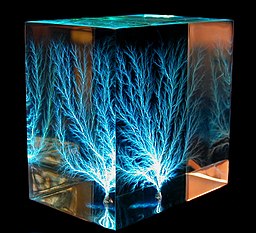Lichtenberg figure

Lichtenberg figures are aesthetically seemingly tree, fern - or star- shaped pattern , which as a result of electrical high voltage s discharges on or in the insulating materials ( dielectric materials are formed). They are named after the German physicist Georg Christoph Lichtenberg , who originally discovered them as two-dimensional patterns in his laboratory when they formed in the dust on the surface of an electrically charged insulator plate. Lichtenberg commented on his discovery in a letter to the Hanoverian official Johann Andreas Schernhagen (1722–1785) (Bw 1, 440, February 5, 1778):
“ During these days I made several experiments on electricity , with the resin dust, which make this discovery more and more important to me. Among other things, I have produced a lot of Concentric Circles with a single blow […]. It is of course played, but such a beautiful educational game that I will never be ashamed of it. "
At that time it was assumed that the typical branching appearance of this electrostatic phenomenon could provide information about the then still puzzling nature of the electrical flow .
Lichtenberg figures typically arise from the rapid electrostatic discharge or redistribution of electrical charges on the surface of insulator plates.
The physical principles underlying the formation of the Lichtenberg figures are the same on which modern electrophotography (xerography) is based, which is used in all common copiers ( photocopiers , laser printers, etc.).
See also
literature
- Haru Hamanaka: Knowledge and image - the history of science of the Lichtenberg figures around 1800. Series: Stefan Brüdermann and Ulrich Joost (eds.): Lichtenberg studies. (Volume 16). Wallstein Verlag , Göttingen 2015. ISBN 978-3-8353-1627-0 .
Web links
- The Lichtenberg figures - website of the Lichtenberg Society e. V.
- Lichtenberg Figures, Glass and Gemstones (English)
- 1927 General Electric Review Article about Lichtenberg Figures (English)
- About Electricity, Lightning, and Lichtenberg Figures (English)
- Dielectric Breakdown Model (DBM) - a mathematical model of the phenomenon (English)
- Mathematical Description of Diffusion Limited Aggregation - a more mathematical description (English)